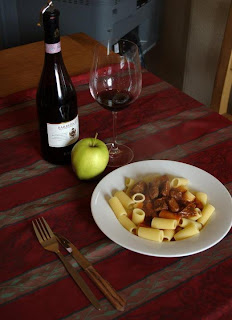XVI century, Annibale Carracci,
Il mangiafagioli (the bean eater),
Galleria Colonna, Rome.
The recipe I am proposing today is the vegetarian variation* of the aubergine Parmigiana: a recipe that takes into account only seasonal ingredients. Aubergines (or eggplant) is the vegetables around which the entire preparation rotates. I wish to suggest a mono-portion recipe, which is excellent for singles, yet also scenographic if used as a starter: it is lighter to digest in comparison with the original recipe which prescribes a double frying process. It is also lighter cause the portion itself is smaller that what "granma would impose you!". Let's begin:
Wash the aubergine
if you find the pale violet variety
is even better, because it is sweeter
Summer is the season of plenty: each day basil, tomatoes, aubergines, courgettes, French beans, peppers, beans are yielded their fruit-bearing plants. Eating seasonal product is a logical attitude, although supermarkets, television and the fridge made it appear an almost old-fashined behavior. It seems indeed easier to grab from the shelf a product that we fancy, without thinking how much it may cost in terms of health and pollution to have peppers and tomatoes in Winter or spinaches and cherries in Summer and oranges in Autumn: these products are old or they come from distant countries only to please our impatience, which should be tamed a bit more.
Summer by Antonio Vivaldi, violin, XVIII century
First of all, prepare a nice tomato sauce, you can either use five fresh tomatoes or a tin of plum tomatoes: perfume it with a clove of garlic, a leaf of basil, a helpful pinch of salt, a sprinkle of black pepper and in the end, after having switched off the hob, add a generous pouring of extra virgin olive oil.
Cut in slices of medium thickness
and fry in abundant extra virgin olive oil.
The action of listening to nature produces a double benefit: it gives us the chance to think about the natural cycle of seasons and helps us to be silent in front of our artificial yearns. After having lost this compass, we dismissed the common sense of consumption, transforming food in a compensation for the stress caused by the capitalistic conception of productivity in life: if every material entity can be objectified we mislay the distance between real objects and non-objects, such as human beings are. Then if you objectify the mass production of your food, which is your fuel, you end up with the idea that we are only a gear of this manufacturing process. The act of listening is one of the main concepts on which Martin Heidegger stressed his perorations, without listening you lose the possibility to receive a sort of call from what is more authentic in you. Moreover, I found a convincing exposition of his concerns about the exploitation of the worlds sources in an interesting essay called The Age of the world picture, in The question concerning technology and others essay:
Lorenzo Oropallo, a dear friend of mine,
will salute with enthusiasm this contamination
between food and philosophy
Salt gently: I prefer using Maldond salt,
cause it is JUST salt, produced
onto the British soil:
The majority of the other salts I came across
are rich of bicarbonate:
These salt flakes are also pleasant as garnishments
Slice mozzarella (possibly not the buffalo one,
cause it is too juicy)
Slice an organic hard boiled egg
Dispose into layers:
for each terrine
3 slices of fried aubergine;
1 slice of mozzarella;
1 slice of hard boiled egg,
tomato sauce.
There are various ideas on the origin of this dish: some believe it has its origin in Naples, some others in the oriental part of Sicily. It arrived probably with the arabs, around the tenth century after Christ, because the aubergine, an asiatic vegetable, was unknown to the romans. The name itself seems to derive from a distorted turkish word (padmegian) that became Parmigiana in the local dialect. My personal idea is that the Parmigiana imitates the idea of the Lasagne, a dish you can eat in Emilia and in Parma, and perhaps, then, the multi-layered preparation was original platonic model. Subsequently, th hybrid between the procedure of the Lasagne and the use of aubergiens produced the modern version of Parmigiana: that's way it may have been originally called Parmigiana di melanzane (aubergines Parmigiana) and not Melanzane alla parmigiana (aubergines done according to the Parma fashion).
Distribute the sauce with the help of a table spoon
Grate some Parmigiano,
I recommend the well 30 months
matured one
Sprinkle with a cheesey snow
This procedure with allow the cheese to melt
onto the the tomato sauce.
Sprinkle with some bread crumbs,
and put it inside the oven for 30 mins,
at 210 °C, gas mark 7-8:
The bread crumbs will give a delightful
crusty armour.
A practical solution to cook them together
in the same baking tray.
Serve on a small dish with some bread,
and above all serve it cold.
























































